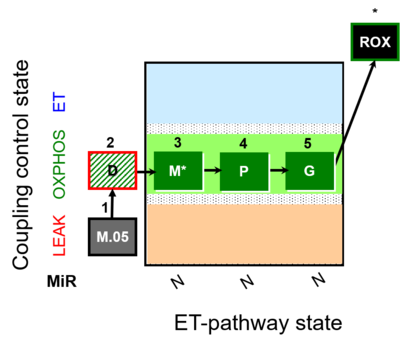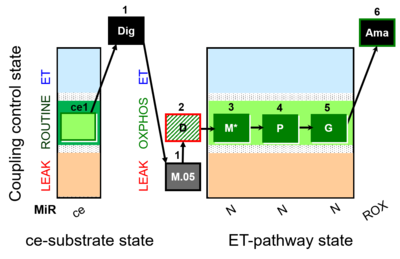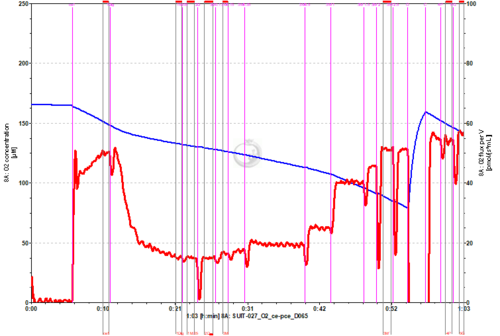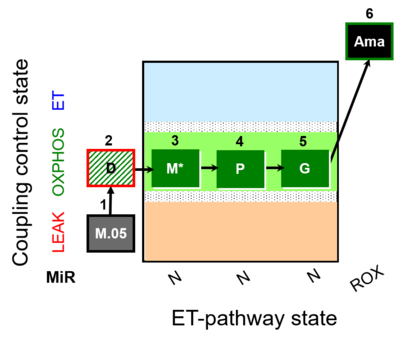Difference between revisions of "SUIT-027"
Garcia Luiz (talk | contribs) |
|||
| Line 5: | Line 5: | ||
}} | }} | ||
::: '''[[SUIT protocol pattern]]:''' ce1;1Dig;1M;2D;3M;4P;5G | ::: '''[[SUIT protocol pattern]]:''' ce1;1Dig;1M;2D;3M;4P;5G | ||
SUIT-027 is focused on the analysis of the [[Malate anaplerotic pathway control state|malate anaplerotic pathway control state]] in [[mitochondrial preparations]] (isolated mitochondria, permeabilized cells, homogenate and permeabilized fibers). [[Malate]] alone does not support respiration if | SUIT-027 is focused on the analysis of the [[Malate anaplerotic pathway control state|malate anaplerotic pathway control state]] in [[mitochondrial preparations]] (isolated mitochondria, permeabilized cells, homogenate, and permeabilized fibers). [[Malate]] alone does not support respiration if oxaloacetate is not metabolized in the absence of acetyl-CoA. The careful titration of malate is required to analyze the activity of the mt-isoform of NADP<sup>+</sup>- or NAD(P)<sup>+</sup>-dependent malic enzyme (mtME). If these enzymes are present in the sample one should be able to reach with malate alone a high respiratory activity comparable to the NADH linked pathway control states with more classical combinations of substrates (e.g. PM or GM). | ||
| Line 21: | Line 21: | ||
== Strengths and limitations == | == Strengths and limitations == | ||
:::+ Multiple titrations with [[malate]] provide information on: | :::+ Multiple titrations with [[malate]] provide information on: | ||
:::# The presence of malate anaplerotic pathway due to mitochondrial [[malic enzyme]] in the sample | :::# The presence of malate anaplerotic pathway due to mitochondrial [[malic enzyme]] in the studied sample. | ||
:::# Malate concentration that does not stimulate malate anaplerotic pathway, and therefore could be used to study [[F-pathway]] without [[N-pathway]] contribution in samples with mt malic enzyme. | :::# Malate concentration that does not stimulate malate anaplerotic pathway, and therefore could be used to study [[F-pathway]] without [[N-pathway]] contribution in samples with mt malic enzyme. | ||
:::- This protocol does not | :::- This protocol does not analyze [[Coupling control state|coupling control]]. | ||
:::- Different [[pathway control states]] are not | :::- Different [[pathway control states]] are not analyzed in this protocol. | ||
== Compare SUIT protocols == | == Compare SUIT protocols == | ||
::::* [[SUIT-007]]: Protocol to | ::::* [[SUIT-007]]: Protocol to analyze glutamate anaplerotic pathway. | ||
::::* [[SUIT-002]]: A low concentration of malate is initially used to assess F-pathway without N-pathway contribution. Further, a higher concentration of malate is added to | ::::* [[SUIT-002]]: A low concentration of malate is initially used to assess F-pathway without N-pathway contribution. Further, a higher concentration of malate is added to analyze N-pathway. | ||
== References == | == References == | ||
Revision as of 17:25, 1 July 2019
Description
Abbreviation: Malate anaplerosis
Reference: A: Malate anaplerotic pathway
- SUIT protocol pattern: ce1;1Dig;1M;2D;3M;4P;5G
SUIT-027 is focused on the analysis of the malate anaplerotic pathway control state in mitochondrial preparations (isolated mitochondria, permeabilized cells, homogenate, and permeabilized fibers). Malate alone does not support respiration if oxaloacetate is not metabolized in the absence of acetyl-CoA. The careful titration of malate is required to analyze the activity of the mt-isoform of NADP+- or NAD(P)+-dependent malic enzyme (mtME). If these enzymes are present in the sample one should be able to reach with malate alone a high respiratory activity comparable to the NADH linked pathway control states with more classical combinations of substrates (e.g. PM or GM).
Communicated by Cardoso LH (last update 2019-07-01)
Specific SUIT protocols
- SUIT-027 O2 ce-pce D065 for permeabilized cells
Steps and respiratory states
| Step | State | Pathway | Q-junction | Comment - Events (E) and Marks (M) |
|---|---|---|---|---|
| 1M.05 | (ML) | ce1;1Dig;1M | ||
| 2D | ( MP) | ce1;1Dig;1M;2D
| ||
| 3M | MP | N | CI | ce1;1Dig;1M;2D;3M
|
| 4P | PMP | N | CI | ce1;1Dig;1M;2D;3M;4P
|
| 5G | PGMP | N | CI | ce1;1Dig;1M;2D;3M;4P;5G
|
| 6Ama | ROX | ce1;1Dig;1M;2D;3M;4P;5G;6Ama
|
- Bioblast links: SUIT protocols - >>>>>>> - Click on [Expand] or [Collapse] - >>>>>>>
- Coupling control
- Pathway control
- Main fuel substrates
- » Glutamate, G
- » Glycerophosphate, Gp
- » Malate, M
- » Octanoylcarnitine, Oct
- » Pyruvate, P
- » Succinate, S
- Main fuel substrates
- Glossary
Strengths and limitations
- + Multiple titrations with malate provide information on:
- The presence of malate anaplerotic pathway due to mitochondrial malic enzyme in the studied sample.
- Malate concentration that does not stimulate malate anaplerotic pathway, and therefore could be used to study F-pathway without N-pathway contribution in samples with mt malic enzyme.
- - This protocol does not analyze coupling control.
- - Different pathway control states are not analyzed in this protocol.
- + Multiple titrations with malate provide information on:
Compare SUIT protocols
References
MitoPedia concepts: MiP concept, SUIT protocol, Recommended
MitoPedia methods:
Respirometry





